Native Son – October, 2010
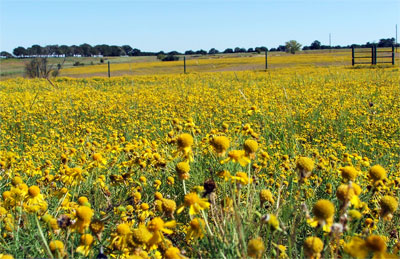
Overgrazing has allowed brilliant bitterweed (Helinium amarum) to make a showing in former grasslands.
All photos by Steven Chamblee.
Fall, Forestburg, and a Little Tortoise
One of my favorite things about autumn is that I don’t have to get up so early to see the sun rise. Reminds me that, sure, the early bird gets the worm, but it’s the second mouse that gets the cheese. And so it was the other day when I headed out before the crack of dawn to visit some folks up in Montague County, north of Decatur. Red River Country … which, of course, brings to mind the year 1977, and my Uncle Bill nostalgically singing, “… just remember that Red River Valley, and the cowboy that’s loved you so true.”

Indiangrass (Sorghastrum nutans)
On the drive up, I pass unusually robust stands of indiangrass (Sorghastrum nutans) along the roadsides, and I wonder if that wet, cold winter gave it a boost this year. A perennial native grass, easily identified by its flat, bluish-tinged leaves and yellow inflorescences, it is the official State Grass of Oklahoma. Indiangrass is perhaps most famous among prairie people as one of the “big four” tall grasses (big bluestem, little bluestem, and switchgrass are the others). When found together in large areas, they serve as indicators for remnants of original tall grass prairie that once covered about 25 million acres of Texas. These days, such remnants are dishearteningly rare, even around here, literally right on the fringes of the 20,000-acre LBJ National Grassland. On a larger scale, only about 4 percent of the original 140 million acres of North America’s tall grass prairie survives today. Most of it disappeared under the steel plow during agricultural expansion. Few people are aware that, given the right environmental conditions, a tall grass prairie can attain a height of 9 to 10 feet … tall enough to literally swallow an entire herd of bison! (They will, of course, do their best to return the favor.)
Forestburg is a quiet little community surrounded by large-acreage cattle ranches. I’ve always appreciated the visual difference between beef ranches and dairy farms (wildflowers are somewhat acceptable on the former and forbidden on the latter, as they often affect the flavor of milk). For a period of time, I did not appreciate either, because both are altered forms of natural prairie. Over the past 30 years or so, as I have watched urban sprawl tidal wave over meadows and rural populations balloon, I have become aware that almost all of the remaining large land parcels are privately owned ranches. Saddled with that thought comes the stark realization that ranchers are not the bane of conservation; they are the champions and the very future of it.
The Red River Master Gardener “colony” (my term, not theirs — endearingly used because they’re just getting started) that I spoke for are down-home sweet and filled with a burnin’ for learnin’. And as anyone who has ever stood behind a podium can attest, education is always a two-way street. Few groups have shared their experiences with me so enthusiastically, and I drove off smarter than when I arrived.
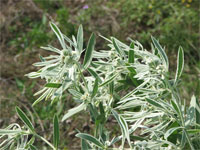
Snow on the Prairie (Euphorbia bicolor)
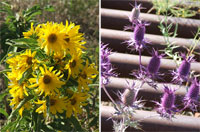
Maximillian sunflower (Helianthus maximiliani). Bushy eryngo (Eryngium diffusum)
Two miles up the road, I had to do a double take for a road that’s seldom seen. I spent a little time in the bar ditches and on the aprons, photographing Snow on the Prairie (Euphorbia bicolor), a lovely green-and-white-striped relative of poinsettia that has genuine ballistic fruits, which literally catapult seed into the air. My lens settles on Maximillian sunflower (Helianthus maximiliani), a super-showy, blossom-smothered beauty that signals the Monarch butterfly migration. After rainy summers, these sunflowers can reach 10 feet; this one’s about waist high. Bushy eryngo (Eryngium diffusum) arises from a cattle guard, holding its spiky bluish-purple flowers candelabra-style up through the steel pipes. A true classic among Texas wildflowers, eryngo can be cut and used in dried flower arrangements, often holding its color for several years. A big ol’ bull (Bovinus testemaximus) draws my attention as well, and I talk gently to him while inspecting the integrity of the fence that separates us … and while it’s “iffy” at best, as long as he thinks it’s impenetrable, I’m okay. (Have you ever noticed the difference in the value of cows vs. horses? It’s in the fence … a few scraggly strands of rusty barbed wire vs. 2-inch steel pipe.) As luck would have it, a few sexy heifers emerge from the scrub, and the bull’s expression changes from bored indifference to a silent version of Robert DeNiro’s iconic “You talkin’ ta ME?” Looks like a nice time of day for a drive, so I head out.
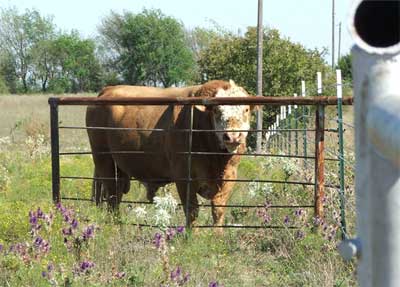
Bull (Bovinus testemaximus)

Bitterweed (Helinium amarum)
A few miles later, a blanket of brilliant yellow brings me to a halt. While flat-out gorgeous, this unusually heavy crop of bitterweed (Helinium amarum) is the result of overgrazing. Grasses and forbs have been eaten away, allowing the unpalatable wildflower to flourish in the absence of competition and form a solid stand. It’s not like bitterweed is a villain or anything; it has simply taken advantage of the opportunity given it. If the pasture were not grazed for a few years, nature would restore the balance, although with fire suppression and invasive species all around, it would never look like it did 150 years ago. Who knows…maybe it would look better than it did back then …? When Mother Nature and Father Time get together, and Baby Entropy runs amuck, anything is possible.
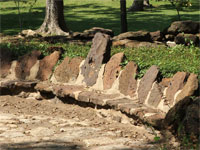
Stone bench in the
Benny Simpson Garden
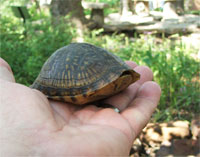
Tortoise in the
Benny Simpson Garden
Three days later and I’m on the campus of Texas Women’s University in Denton, searching for the Benny Simpson Garden I’ve been told about. A few wrong turns bring me to a little hillside garden strung with aging flagstone paths and magnificently crafted stone benches. The old University Garden still needs a lot of work, no doubt, but there is evidence all around that someone is working to bring this small wonder back to life. I imagine my friend Mark and me running crews of community service workers — repairing the pond pumps, mortaring aging stone walls, re-establishing buried pathways. I imagine students and Master Gardeners side by side, planting native species, rolling out soaker hoses, smiling and laughing as the jewel takes polish. Optimistically, it could happen in four weekends. I laugh a bit to myself … like I have the time. Like anyone would want to pitch in. Like someone would pony up some mortar and some tools. I look skyward and say out loud, “Benny, if you want it to be so, you’ll have to give me a sign!” A little scratch on my foot gets my attention, courtesy of a small tortoise. He retracts as I pick him up, and remains inside when I ask, “Are you the sign?”
What do you think?
Peace & love,
Steven
Autumn in Texas…
Glorious wildflowers abound,
Asters and goldenrod rise from the ground.
Botanical rainbows…
Paint the prairies with ease,
Grasses and gayfeather wave in the breeze.
Mother’s Nature’s glory,
Always amazes my eyes,
Colorful quilts wave under blue skies.
About the author: Steven Chamblee is the chief horticulturist for Chandor Gardens in Weatherford and a regular contributor to Neil Sperry’s GARDENS magazine and e-gardens newsletter. Steven adds these notes:
Come out to Chandor Gardens and see us sometime. Just take I-20 west to exit 409, hang a right, go 2.1 miles and hang a left on Lee Avenue. Head straight 12 blocks and you’re driving in the gates. Call 817-361-1700 to let us know you’re coming, and we’ll light the incense and show you around. You can always go to www.chandorgardens.com for a picture tour and more information.
I can always use another road trip! Let me know if you’d like me to come out and speak to your group sometime. I’m low-maintenance, flexible, and you know I like to go just about anywhere. No city too big; no town to small. Just send me an e-mail at schamblee@weatherfordtx.gov and we’ll work something out.

